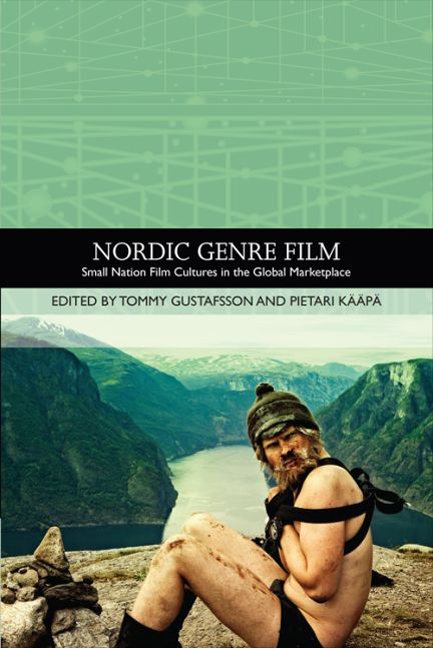Book contents
- Frontmatter
- Contents
- List of Illustrations
- List of Contributors
- Traditions in World Cinema
- Introduction: Nordic Genre Film and Institutional History
- PART I HERITAGE CINEMA AND NATIONAL NARRATIVES
- PART II CRIME AND DETECTIVE NARRATIVES
- 4 Crime Up North: The Case of Norway, Finland and Iceland
- 5 The Thrill of the Nordic Kill: The Manhunt Movie in the Nordic Thriller
- 6 Bridges and Tunnels: Negotiating the National in Transnational Television Drama
- 7 Stockholm Noir: Neoliberalism and Gangsterism in Easy Money
- 8 The Private Life of the Prime Minister? Politics, Drama and Documentary in Pääministeri and Palme
- PART III NORDIC OPTIMISM: ROAD MOVIES, COMEDIES AND MUSICALS
- PART IV NORDIC HORRORS
- PART V GENRE BENDERS
- Index
5 - The Thrill of the Nordic Kill: The Manhunt Movie in the Nordic Thriller
from PART II - CRIME AND DETECTIVE NARRATIVES
Published online by Cambridge University Press: 25 October 2017
- Frontmatter
- Contents
- List of Illustrations
- List of Contributors
- Traditions in World Cinema
- Introduction: Nordic Genre Film and Institutional History
- PART I HERITAGE CINEMA AND NATIONAL NARRATIVES
- PART II CRIME AND DETECTIVE NARRATIVES
- 4 Crime Up North: The Case of Norway, Finland and Iceland
- 5 The Thrill of the Nordic Kill: The Manhunt Movie in the Nordic Thriller
- 6 Bridges and Tunnels: Negotiating the National in Transnational Television Drama
- 7 Stockholm Noir: Neoliberalism and Gangsterism in Easy Money
- 8 The Private Life of the Prime Minister? Politics, Drama and Documentary in Pääministeri and Palme
- PART III NORDIC OPTIMISM: ROAD MOVIES, COMEDIES AND MUSICALS
- PART IV NORDIC HORRORS
- PART V GENRE BENDERS
- Index
Summary
‘This world's divided into two kinds of people: The hunter and the hunted,’ big-game hunter Rainsford says in The Most Dangerous Game (1932) and self-assuredly continues, ‘Luckily, I'm a hunter. Nothing can ever change that.’ Well, he will discover that in the manhunt movie even the hunter can become prey. The manhunt movie is a subgenre of the Hollywood thriller which joins two elements: big-game sport hunting and hunting humans. Sport hunting stirs up themes of nature and culture, morals and ethics, masculinity, and, finally, civilisation. Here, we will ask what happens when the subgenre is used in the Nordic thriller.
The chapter has three aims. First, it establishes the central generic traits of the manhunt movie. Second, it sets up a theoretical framework of sociobiological and ecological theories with hunting as a reference point. And, third, it examines the Nordic version of the manhunt movie focusing on the themes of hunting, nature, social standing and civilisation. I look at the Danish drama The Hunt (Thomas Vinterberg, 2012), the Norwegian thriller-heist-comedy Headhunters (Morten Tyldum, 2011) and the Swedish thrillers The Hunters (Jägarna, 1996) and False Trail (Jägarna 2, 2011) by Kjell Sundvall.
THE MANHUNT MOVIE
Since I cannot claim extensive knowledge of manhunt movies I will approach the subgenre with modesty. Some may claim that sport hunting of human game is not a genre but just a theme or a trope. I leave this discussion for others and will regard it a subgenre of the thriller and call it the manhunt movie.
The idea of combining sport hunting with hunting humans originates from Richard Connell's short story ‘The Hounds of Zaroff’ (1924) which was adapted as The Most Dangerous Game in 1932. Connell was inspired by biggame hunting in Africa, Asia and South America, which was popular among rich Americans in the 1920s.2 In Connell's story the big-game hunter Rainsford falls off a yacht in the Caribbean and swims to an isolated island owned by a Russian aristocrat, general Zaroff. Zaroff is a big-game hunter who has bought an island where he hunts shipwrecked sailors. At first Zaroff thinks he can share his unique ‘game’ with this fellow hunter, but Rainsford declines.
- Type
- Chapter
- Information
- Nordic Genre FilmSmall Nation Film Cultures in the Global Marketplace, pp. 76 - 90Publisher: Edinburgh University PressPrint publication year: 2015



